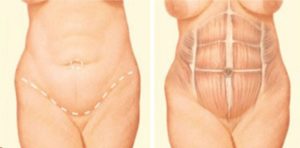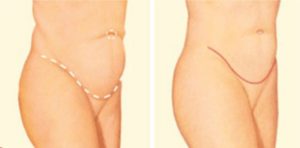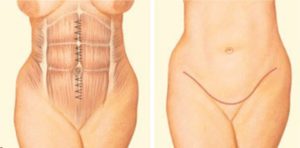By Dr. Robert H. Gotkin, MD, FACS
The Ipanema Tummy Tuck®, also known as a laser-assisted lipoabdominoplasty, removes loose skin and excess fat and, in most cases, tightens weakened, lax or stretched-out abdominal muscles creating or restoring a smoother, firmer and flatter abdomen. It is my unique method of performing body contouring of the trunk involving abdominoplasty.
Tummy Tuck or Liposuction?
My patients almost always seem to ask me, “Should I have a tummy tuck or liposuction?” A flat, well-toned abdomen is something that many of us endeavor to reach through exercise and weight control. Sometimes, however, these methods cannot achieve our goals. Even individuals of otherwise normal body weight and proportion can develop an abdomen that protrudes or is loose and sagging. The most common causes include:
- Aging
- Heredity
- Pregnancy
- Prior surgery
- Significant fluctuations in weight
I have a nickname for that excess fat that you just can’t seem to lose – no matter how much you diet and exercise – FRED : F at R esistant to E xercise and D iet. This is the fat that is appropriately treated with liposuction or a tummy tuck. But how do you decide which procedure is best? If you have good skin tone and no significant skin laxity or loose skin in the areas of excess fat, liposuction may be the right procedure for you. But if you have significant skin laxity and weakened, lax or stretched-out “sit-up” muscles in your abdomen, liposuction alone is not the best answer. That’s where the Ipanema Tummy Tuck comes in.
Who is a candidate for the Ipanema Tummy Tuck?
The Ipanema Tummy Tuck is a highly individualized procedure and, as in all cosmetic surgery, you should do it for yourself, not to fulfill someone else’s desires or to try to fit any sort of ideal body image. In general, you may be a good tummy tuck candidate if:
- You are physically healthy and at a stable weight
- You have realistic expectations
- You are a non-smoker
- You are bothered by the appearance of your abdomen
What any tummy tuck won’t do
A tummy tuck is not a substitute for weight loss or an appropriate exercise program. Although the results of a tummy tuck can be quite long-lasting, the positive outcome can be greatly undermined and diminished by significant fluctuations in your weight. For this reason, individuals who are planning substantial weight loss or women who may be considering future pregnancies are often advised to postpone a tummy tuck.
A tummy tuck cannot correct stretch marks – although some may be removed if they are located on the areas of excess skin that will be excised.
Recovery after an Ipanema Tummy Tuck
During your tummy tuck recovery, dressings or bandages will be applied to your incisions, and you will be asked to wear an elasticized compression garment to minimize swelling and support your abdomen as it heals following surgery.
Many surgeons use drains during a tummy tuck; these are small, thin tubes temporarily placed under the skin to drain any excess blood or fluid that may collect. Part of the Ipanema Tummy Tuck is wound closure without the use of drains. In fact, I have not had to use drains since I developed the Ipanema Tummy Tuck in 2009!
You will be given specific instructions that will include:
- How to care for the surgical site
- Medications to apply or take orally during the recovery process
- Specific concerns to look for at the surgical site or in your general health
- When to follow up
Be sure to ask me specific questions about what you can expect during your individual recovery period:
- Where will I be taken after my surgery is complete?
- What medication will I be given or prescribed after surgery?
- Will I have dressings/bandages after surgery? When will they be removed?
- When will the stitches be removed?
- How can I shower or bathe?
- How long will I wear the elasticized garment?
- When can I resume normal activity and exercise?
- When do I return for follow-up care?
Results of the Ipanema Tummy Tuck
The final results of an Ipanema Tummy Tuck may be initially obscured by swelling and your inability to stand fully upright until internal healing has progressed a bit.
Within a week or so, you should be standing tall and confident in your new slimmer profile.
Your tummy tuck will result in a flatter, firmer abdominal contour that is more proportionate with your body type and weight. The addition of circumferential contouring by liposuction will further enhance your overall appearance. Previous abdominal surgery may limit the potential results of any tummy tuck.
Tummy tuck scarring
In women who have undergone cesarean section, your existing scar will likely be incorporated into the new scar. There will also be a circular scar around the belly button. Part of the concept of the Ipanema Tummy Tuck is circumferential body contouring of the trunk. Therefore, liposuction is usually performed in the hips and flanks; this is associated with tiny (3-4mm) scars. If skin excess is significant in these areas, the tummy tuck incision may be extended around the hips and towards the back to give you the best possible aesthetic result.
The Ipanema Tummy Tuck scars may take several months to a year or more to fade as much as it will. This is normal and expected. Patience is a virtue!
Although good results are expected from your procedure, there is no guarantee. In some situations, it may not be possible to achieve optimal results with a single surgical procedure and further surgery may be necessary.
Following all instructions – both before and after surgery – is essential to the success of your surgery and achievement of the best possible outcome.
It’s important that the surgical incisions are not subjected to excessive force, swelling, abrasion, or motion during the time of healing. I will give you specific instructions on how to care for yourself.
Ipanema Tummy Tuck procedure steps
An Ipanema Tummy Tuck includes the following steps:
Step 1 – Photos will be taken and preoperative markings are placed while you are standing up just prior to surgery.

Step 2 – Anesthesia
Medications are administered for your comfort during the surgical procedure. The choices include intravenous sedation and general anesthesia. The anesthesiologist and I will recommend the best choice for you. In addition, your tissues will be infiltrated with tumescent local anesthesia solution. This facilitates the liposuction and significantly diminishes bleeding during surgery.
Step 3 – Laser-assisted liposuction

The laser is inserted into the tissues to “melt” the fat – transform it from a soft solid to a liquid. The liquefied fat is then gently withdrawn under very low intensity liposuction. Most often, your abdomen, hips and flanks will be treated as part of the Ipanema Tummy Tuck. Other areas can be added by discussing with me prior to surgery.
Step 4 – The incision

The Ipanema Tummy Tuck requires a horizontally-oriented incision that is at the pubic hairline in the middle of the abdomen and then angles up towards the hip bones on the sides. In addition, there is a circular incision around the belly button.
The shape and length of the skin incision – how far it will extend backwards – is determined by the amount of excess skin. Once the abdominal skin is lifted, the underlying weakened, stretched-out abdominal “sit-up” muscles are repaired. This helps to give you a firm, flat tummy.
The upper abdominal skin is pulled down like a window shade. The excess skin is trimmed and the remaining skin is sutured together. A new opening for the belly button is created. The belly button is popped through to the surface and sutured into position. If you have a particular shape and contour of your belly button that you like and want to preserve, please be sure to discuss this with me.
Step 5 – Closing the incisions
Sutures, skin adhesives and tapes are used to close the skin incisions. And remember, no drains! One more bonus of the Ipanema Tummy Tuck: I use a long-acting local anesthetic in the sit-up muscles that lasts for ~3 days. This helps with pain control during the early recovery phase. In fact, many of my patients take only plain Tylenol following an Ipanema Tummy Tuck – not like the other tummy tucks about which you’ve heard.
Step 6 – Recovery and revel in the New You!
The Ipanema Tummy Tuck will result in a flatter, firmer abdominal contour that is more proportionate with your body type and weight.
Tummy tuck risks and safety
The decision to have plastic surgery – and an Ipanema Tummy Tuck, in particular – is extremely personal, and you’ll have to decide if the benefits will achieve your goals and if the risks and potential complications of such surgery are acceptable to you.
You will be asked to sign consent forms to ensure that you fully understand the procedure and any risks.
Tummy tuck risks include:
- Risks of Anesthesia
- Bleeding
- Infection
- Fluid accumulation (seroma)
- Poor wound healing
- Skin loss
- Numbness or other changes in skin sensation
- Skin discoloration and/or prolonged swelling
- Unfavorable scarring
- Recurrent looseness of skin
- Fatty tissue found deep in the skin might die (fat necrosis)
- Deep vein thrombosis, cardiac and pulmonary complications
- Asymmetry
- Sub-optimal aesthetic result
- Possibility of revisional surgery
- Persistent pain
These risks and others will be fully discussed prior to you signing the consent. It’s important that you address all your questions directly with me.
Your tummy tuck consultation
During your tummy tuck consultation, be prepared to discuss:
- Your surgical goals
- Medical conditions, drug allergies and medical treatments
- Current medications, vitamins, herbal supplements, alcohol, tobacco and drug use
- Previous surgeries
I will also:
- Evaluate your general health status and any pre-existing health conditions or risk factors that may pose additional risk during and after the surgery. Safety is paramount and considerable effort is directed towards ensuring a safe surgical procedure.
- Take photographs (usually on the day of surgery)
- Discuss your options for body contouring
- Recommend a course of treatment
- Discuss likely outcomes of the Ipanema Tummy Tuck and any risks or potential complications
The success and safety of your body contouring procedure depends very much on your complete candidness during your consultation. You’ll be asked a number of questions about your health, desires and lifestyle.
The consultation is the time to ask me your questions. To help, I have prepared a checklist of questions to ask him that you can bring with you to your consultation.
It’s very important to understand all aspects of your tummy tuck procedure. It’s natural to feel some anxiety, whether it’s excitement for your anticipated new look or a bit of anxiety. Don’t be shy about discussing these feelings with me.
Preparing for tummy tuck surgery
In preparing for tummy tuck surgery, you will be asked to:
- Get lab testing and a preoperative medical evaluation
- Take certain medications or adjust your current medications
- Stop smoking (I will not perform an Ipanema Tummy Tuck on a smoker)
- Avoid taking aspirin, anti-inflammatory drugs and herbal supplements as they can increase bleeding
Your Ipanema Tummy Tuck will most likely be performed in my accredited office-based surgical facility (accreditation by the American Association for the Accreditation of Ambulatory Surgical Facilities, Inc.); it can also be performed in a hospital.
The Ipanema Tummy Tuck is most often performed on an outpatient basis, so be sure to arrange for someone to drive you to and from surgery and to stay with you for at least the first night following surgery. If you wish, I can arrange for a registered nurse to go home and stay with you overnight.
Tummy tuck words to know
- Abdominoplasty: A surgical procedure to correct the apron of excess skin hanging over your abdomen
- Diastasis: Condition in which abdominal muscles have separated
- Hematoma: Blood pooling beneath the skin
- Intravenous sedation: Sedatives administered by injection into a vein to help you relax prior to surgery
- Laser-Assisted Liposuction: A procedure to “melt” the excess fat, turn it into a liquid and then gently draw off the excess fatty liquid from under the skin. This type of liposuction is much more gentle and less traumatic to the remaining tissues.
- Sutures: Stitches used by surgeons to hold skin and tissue together
- Tumescent local anesthesia: a large volume of very dilute local anesthetic that is infiltrated directly into the areas for liposuction and the Ipanema Tummy Tuck
Questions to ask during your consultation
Use this checklist as a guide during your tummy tuck consultation (some are already answered):
Are you certified by the American Board of Plastic Surgery? Yes
Were you specifically trained in the field of plastic surgery? Yes, at Georgetown University
How many years of plastic surgery training have you had? A total of 8 years after medical school
Do you have hospital privileges to perform this procedure? Yes
If so, at which hospitals? Hospitals in the Northwell System on Long Island and in Manhattan
Is the office-based surgical facility accredited by a nationally- or state-recognized accrediting agency, or is it state-licensed or Medicare-certified? Yes (AAAASF, Inc)
Am I a good candidate for this procedure?
What will be expected of me to get the best results?
Where and how will you perform my procedure?
What surgical technique is recommended for me?
How long of a recovery period can I expect, and what kind of help will I need during my recovery?
What are the risks and complications associated with my procedure?
How are complications handled?
How can I expect my stomach to look over time? After pregnancy?
What are my options if I am dissatisfied with the cosmetic outcome of my tummy tuck?
Do you have before-and-after photos I can look at for this procedure and what results are reasonable for me?
